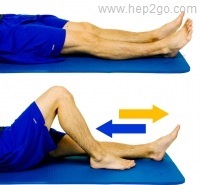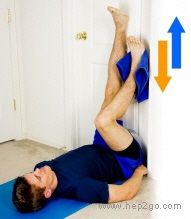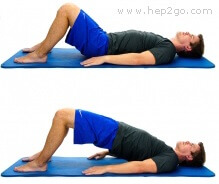- Home
- Knee Surgery
- ACL Surgery
- Rehab
ACL Rehab Protocol
Written By: Chloe Wilson, BSc(Hons) Physiotherapy
Reviewed by: KPE Medical Review Board

An ACL rehab protocol is designed to work through a graded return to exercise and activities to ensure that you make a full recovery after ACL surgery.
ACL rehab is a slow process and it can take up to a year to return fully to sports but it is really important not to rush things.
When an ACL rehab protocol is followed, the success rate of surgery is excellent with approximately 90% of patients returning to their pre-injury activity levels. Most of the problems associated with ACL reconstruction surgery comes either from a poorly designed rehab program, or failure to comply with the program.
ACL Reconstruction Surgery
ACL reconstruction surgery is advised for people who have torn their ACL and are either:

- Having problems with recurrent instability
- Wanting to return to pivoting type sports e.g. football, skiing
You can find out more about the indications for surgery in the ACL surgery overview. During surgery, the ACL is replaced with a new graft, fashioned either from the patella tendon, hamstring tendon or donor tissue. ACL surgery is usually done arthroscopically (keyhole surgery).
An ACL rehab protocol is split into 5 phases of recovery, each targeting different areas of rehab and recovery.
ACL Rehab Protocol Guide
ACL surgery rehab will vary slightly depending on the graft that was used, the surgeon’s technique and whether there was any associated damage at the time of injury. Some surgeons will want you to wear a knee brace for a while, others will limit the amount of flexion at your knee initially.
Here, you will find a guide to some of the most commonly used ACL rehab exercises and drills used during the different phases of the recovery from an ACL reconstruction. But remember, this is a guide. Always check with your doctor or physical therapist before starting any new exercises or progressing on to the next phase of rehab.
Phase 1: First 2 Weeks
Phase 1 of an ACL rehab protocol aims to:
- Reduce Swelling
- Regain Full Knee Extension (straightening)
- Regain Knee Flexion: your surgeon might limit the amount of flexion he wants you to achieve in this phase depending on the surgical technique
- Regain Normal Walking Pattern: by end of phase without walking aids
Here you will find some exercises typically used during the phase 1 of an ACL rehab protocol.
1. Quad Clenches
- Aim: strengthen the quads and regain knee extension
- Starting Position: Lying flat or sitting up with your leg stretched out, heel resting on a prop such as rolled up towel or phone book so it is slightly raised and the knee is free (nothing underneath it)
- Action: Push the knee gently downwards by tightening the muscles on the front of the thigh until you feel a stretch in the back of your knee. Hold for 10 seconds and repeat 10 times, 3-4 times daily
2. Heel Slides
- Aim: Loosen the knee and regain flexion without requiring much strength
- Starting Position: Lying flat or sitting up with your leg stretched out
- Action: Slide your heel towards your bottom, bending your hip and knee. Keep your foot in contact with the bed/floor throughout. Hold for 3-5 seconds and then straighten the leg back out. Repeat 10-20 times, 3-4 times daily
- Top Tip: Place a plastic carrier bag or smooth tray underneath your heel so there is less friction, making it easier to slide the heel
3. Wall Slides
- Aim: Regain knee flexion
- Starting Position: Lie on your back with your legs up on a wall or closed door
- Action: Slowly slide your foot down the wall as far as possible, bending the knee. Hold for 3-5 seconds. Then push the foot gently into the wall and slide the foot back up until the knee is straight. Repeat 10-20 times, 3-4 times daily
- Progression: You can progress this exercise by hooking your other foot over the top of your affected leg and gently pushing down, to further increase flexion
- Top Tip: You can reduce the friction by placing a small towel underneath your heel (as shown in the picture)
Phase 2: Weeks 2-6
Phase 2 of ACL rehab protocol aims to:
- Regain Full Range Of Movement: flexion and extension
- Retrain Balance & Proprioception
- Improve Muscle Strength
- Wean Off ACL Brace: if using one
Here you will find some exercises typically used during the phase 2 of an ACL rehab protocol
1. Wall Squats
- Aim: Increase quads strength and control. Doing squats against the wall instead of free squats helps ensure better control and makes it slightly easier. You can progress to doing them away from the wall
- Starting Position: Stand leaning against a wall, feet apart and a few inches away from the, toes pointing forwards
- Action: Slowly slide down the wall allowing the knees to bend. Check with your physio how far to go, (usually around 45 degrees knee flexion initially). Hold for 5 seconds and then slide back up straight. Repeat 10-20 times, 3-4 times daily
- Top Tips: a. It can help to place a soft ball (football sized) in between your knees and gently squash it slightly as you do this exercise as it helps target the kneecap muscles
b. Make sure your kneecap stays in line with your second toe i.e. does not move inwards as you squat
2. Bridging
- Aim: Strengthen the quads, hamstrings, glutes and core
- Starting Position: Lie on your back with your knees bent, feet flat on the floor
- Action: Clench your glutes and slowly lift your hips up off the floor until you are resting on your shoulder blades (there should be a straight diagonal line from your knees to your shoulders). Hold for 5 seconds and slowly lower. Repeat 10-20 times, 3-4 times daily
- Top Tips: Make sure you don’t arch your back
- Progression: Perform a bridge and then straighten one leg out, without dropping your hips. Hold for 5-10 seconds and then lower. Repeat on the other side.
3. Prone Knee Bends

- Aim: Improve knee flexion and hamstring function
- Starting Position: Lie on your tummy, legs stretched out. Hook the unaffected foot underneath the operated leg
- Action: Leading with the unaffected leg, bring your feet towards your bottom, bending the knees, keeping your hip and knee in contact with the floor/bed. Hold for 10 seconds and slowly lower the legs down. Repeat 10-20 times, 3-4x daily
- Top Tips: a. Clench your glutes slightly as you do this to stop your back arching
b. By getting the unaffected leg to lead the movement, you avoid putting too much strain through the new graft
c. In phase 3 of rehab you can add a weight with this exercise
4. Balance Exercises
Retraining balance and proprioception is really important in this phase of an ACL rehab protocol. The simplest way to start is to practice standing on one leg. Sounds simple, but see how long you can balance for, comparing your operated and non-operated side. It can help to keep a record to see how you are progressing.
Once you can stand on one leg happily for around thirty seconds, try some of the following variations, whilst still standing on one leg:
- Reach forwards and sideways with your arms
- Throw and catch a ball (either to someone or against the wall)
- Close your eyes: much harder than it sounds!
5. Other Activities
Other activities that are suitable at this stage of the ACL rehab protocol include:
- Step Ups: Stepping up and down on a small step, leading with your operated leg
- Cycling: Start on a static bike with low resistance for about 5 minutes
- Heel Raises: Push up onto your tiptoes to strengthen your calf muscles. Progress to doing this on one leg
- Upper Body strength work
- Stretches: for the quads, hamstrings and calf muscles – see the knee stretches section
ACL Rehab Phase 3: Weeks 6-12
Phase 3 of the ACL rehab protocol is the time to be extra careful, as the new graft is at its weakest in this phase. Before progressing to phase 3, you should have regained full range of movement, both flexion and extension and there should be no swelling.
Here, the goals are to:
- Regain more strength, endurance and proprioception: starting to use functional multi-plane activities
- Develop dynamic flexibility
Let's look at some exercises and activities that usually feature in Phase 4 of an ACL rehab protocol.
1. Single Leg Squats
- Aim: Improve strength, stability and control
- Starting Position: Stand on the operated leg, holding something for balance e.g. table or wall
- Action: Bend your knee and lower your body towards the floor. Ensure that your knee stays in line with your second toe and does not move in front of your foot (you should be able to see your toes throughout). Hold for 5-10 seconds and then return to standing position. Repeat 10-20 times, 2-3 times daily
2. Balance Activities
Now, you are aiming to make balance an unconscious phenomenon – your body needs to learn how to balance and make the necessary adjustments without you having to think about it – that is what proprioception is all about.
You can progress your one leg standing exercises in the following ways:
- Standing on a wobble board/balance board: there is no end to the activities you can do on these e.g. throwing and catching, one leg standing, small squats etc
- Sport related activities balancing on operated leg: e.g. soccer drills and racquet or stick manoeuvers
- Cone taps: arrange cones in a circle around you and reach to touch them so moving in all directions
3. Other Activities
Other drills you can do at this stage of ACL rehab protocol include:

- Skipping: start with small strides at low velocity. You can go forwards, backwards and sideways
- Side steps
- Carioca steps: crossing one leg in front, one behind
- Tip toe and heel walking: walking on your tip toes or heels
- Heel to toe walking in different directions: backwards, forwards, circles, figures of 8 etc. You can lay a rope out on the floor in different patterns and walk on it so changing direction
- Lunge exercises: forwards, backwards and sideways as guided by your physical therapist
Activities that are suitable at this point of the ACL rehab protocol are:
- Swimming: front crawl only. No breast stroke until approximately 4 months
- Cycling: Increase resistance of static bike. Progress to outdoor cycling as advised
- Jogging: Start by running at about 40% normal pace, only in a straight line.
You may also be able to starting jumping and landing activities in this phase – be guided by your physical therapist
ACL Rehab Phase 4: 3-6 months
Phase four of an ACL rehab protocol is to prepare you for returning to sport. It will focus on sport specific drills tailored for you and will incorporate high level balance and proprioception work and plyometric exercises. You will be aiming to:
- Regain control of impact activities: progressing from double leg to single leg work
- Introduce start and stop movements: as well as changing direction
- Regain confidence to participate in sports
You will continue with the drills and proprioception exercises from phase 3 but will work on increasing the speed and size of movements. You will also start working on:

- Jumping activities: practising both push offs and landings. Examples of activities you might do include squat jumps, box jumps, rotational jumps doing all of these in different directions
- Stop and Go activities: Jogging a few paces then stopping, then setting off again (thus practising quick acceleration and deceleration activities). Again this should be multi-directional.
- Hopping: working on height, distance and speed
- Cutting and pivoting drills: starting at low speed and ensuring equal weight on each leg (not favouring the operated leg)
ACL Rehab Phase 5: 6-9 months +
By this stage, ACL rehab protocol really depends on what you are wanting to get back to. You will continue to work on strength, power, endurance and proprioception work but it will be tailored to the sports you are planning to return to. It is essential that you follow the advice of your physio and aren’t tempted to return to sports before you’ve been given the green light.
Want To Know More?
An ACL rehab protocol may seem long, arduous and restrictive, but it is designed to ensure the new graft is protected and that you regain full strength and stability of your knee so that you can make a full recovery.
You can find out more about ACL injuries, surgery, common problems and recovery in the following sections:
- ACL Injury Overview: Causes, symptoms and diagnosis
- ACL Surgery: Do you need surgery and what does it involve
- ACL Reconstruction: What happens before, during and after surgery
- ACL Surgery Problems: Potential problems encountered after surgery
- Recovering From Surgery: Recovery time guide following surgery
- ACL Rehab Protocol: Rehab exercises & activities after surgery
- Injury Prevention: How to avoid an ACL knee injury
Page Last Updated: 10/01/23
Next Review Due: 10/01/25














